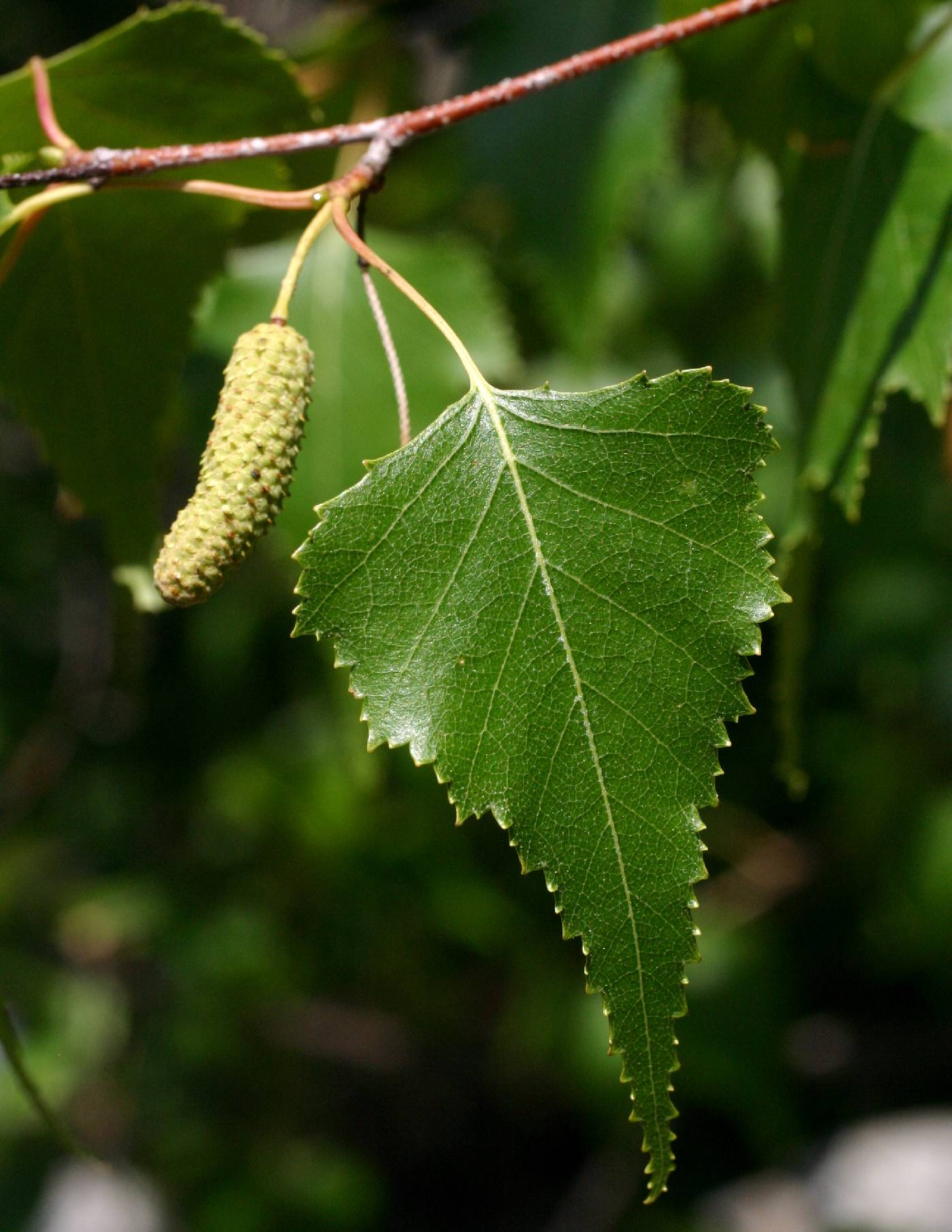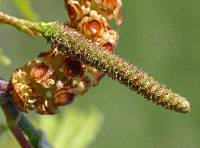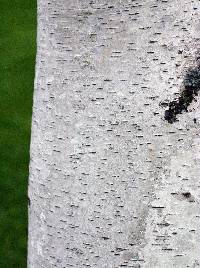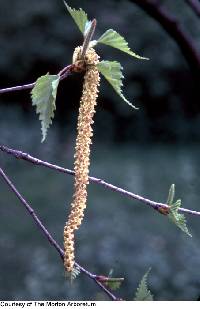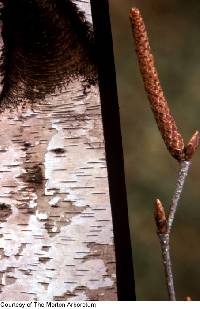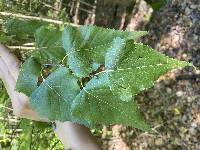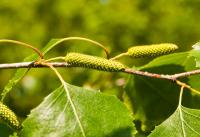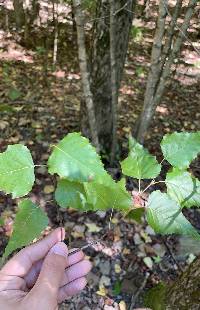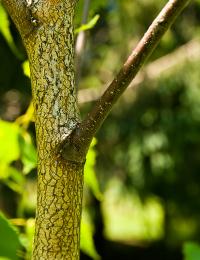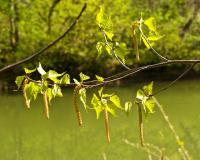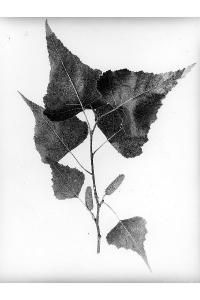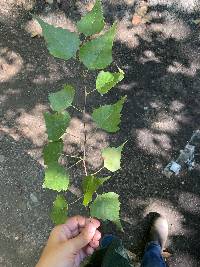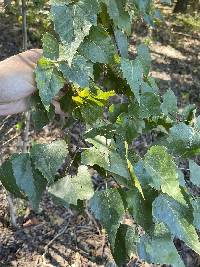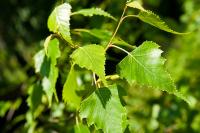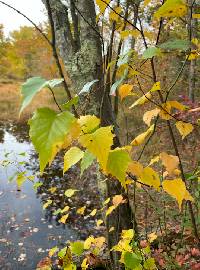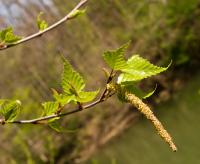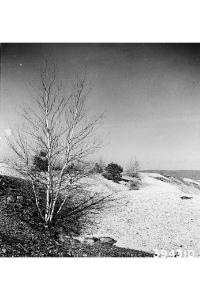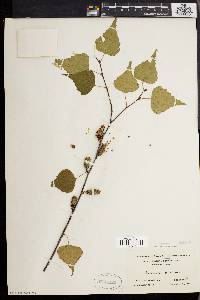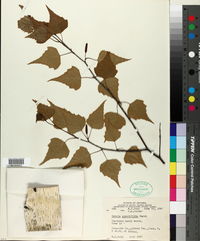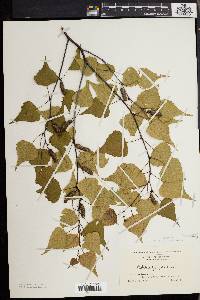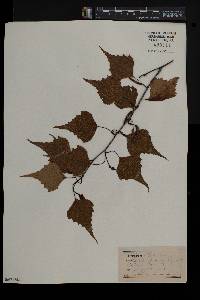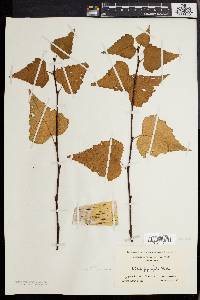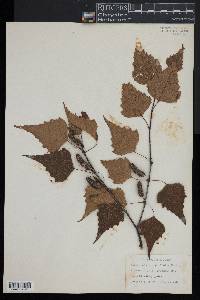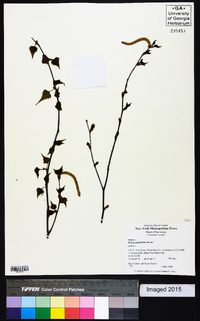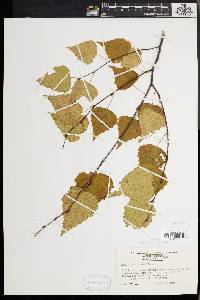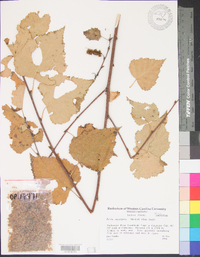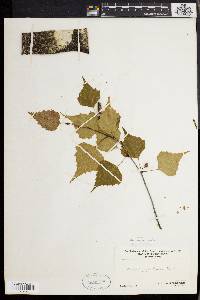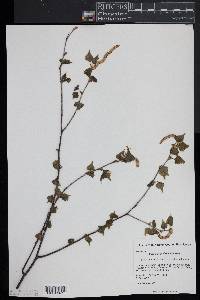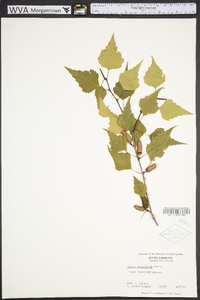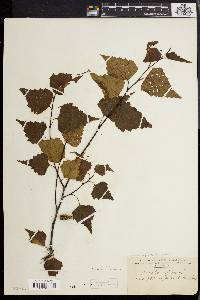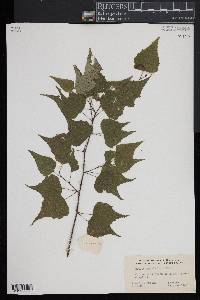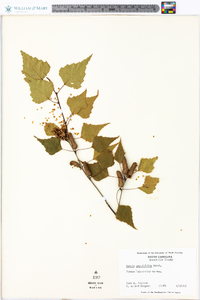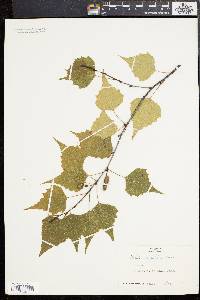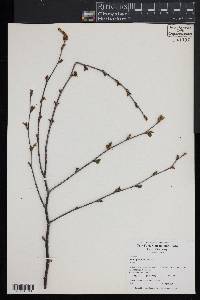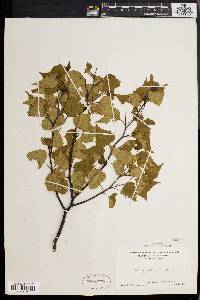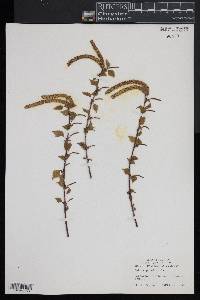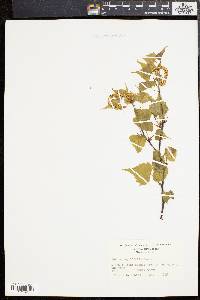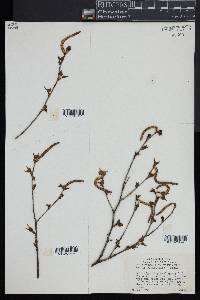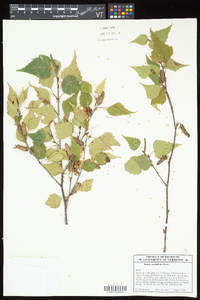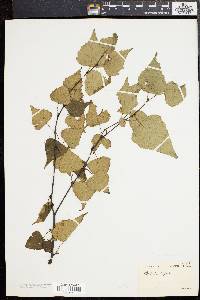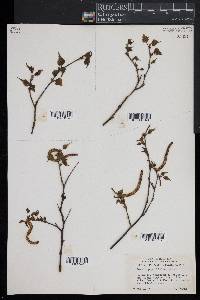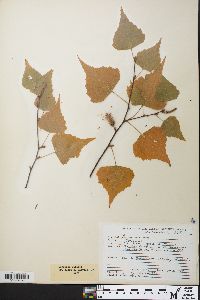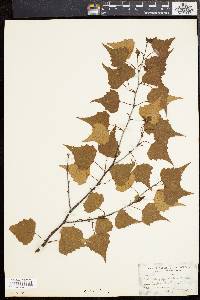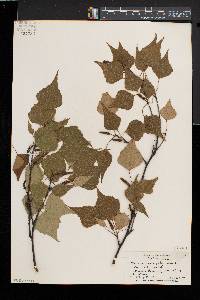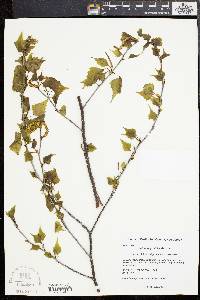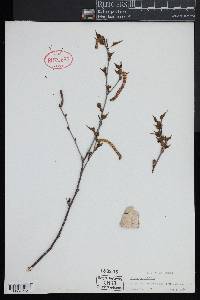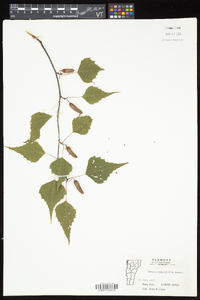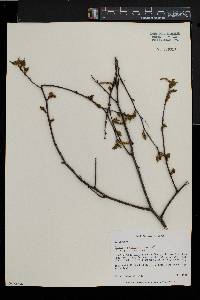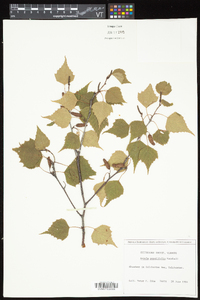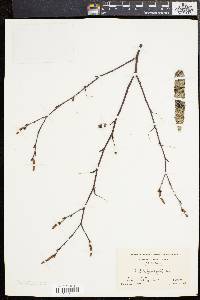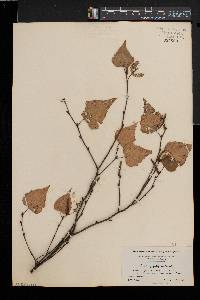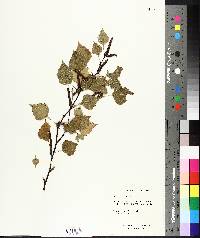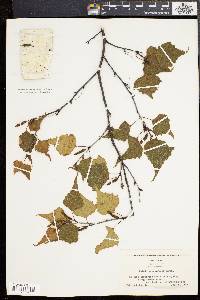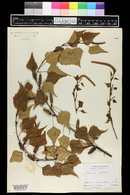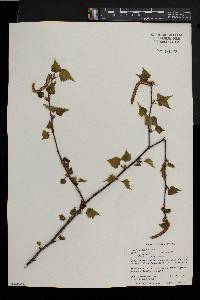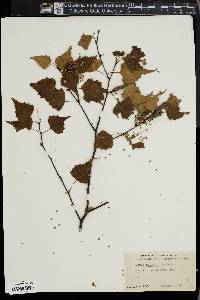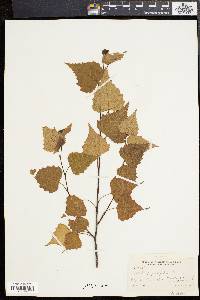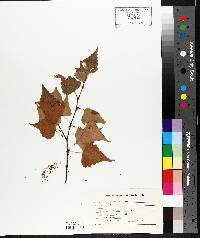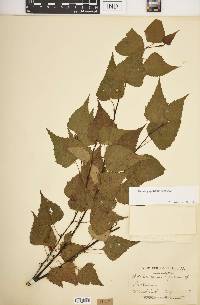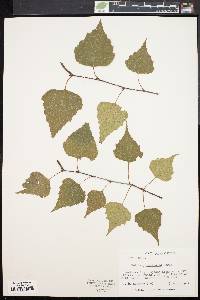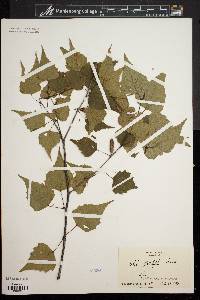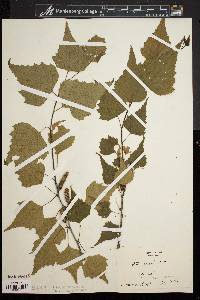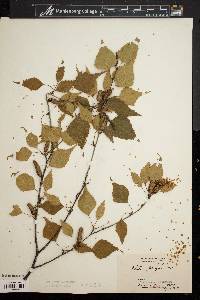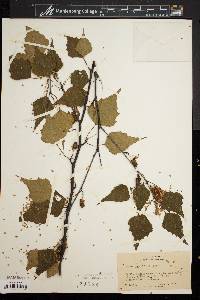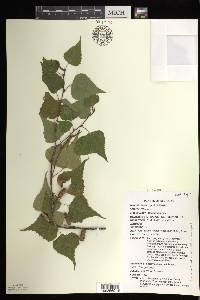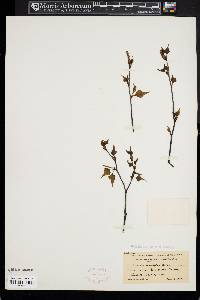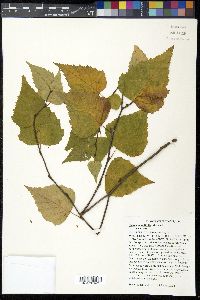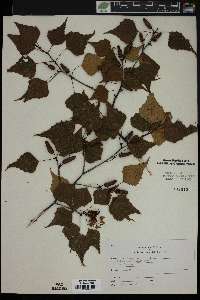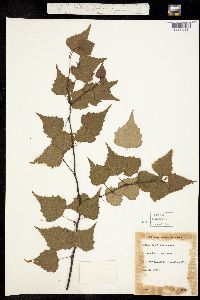
|
|
|
|
Family: Betulaceae
Gray Birch, more...fire birch
[Betula alba var. populifolia (Marshall) Spach, moreBetula populifolia f. incisifolia Fernald, Betula populifolia var. laciniata Loudon] |
Trees , broadly pyramidal, to 10 m; trunks usually several. Bark when young dark reddish brown, in maturity becoming grayish white, smooth, close; lenticels dark, horizontally expanded. Twigs without taste and odor of wintergreen, glabrous to sparsely pubescent, dotted with small, inconspicuous, resinous glands. Leaf blade broadly ovate to deltate or rhombic with 5--18 pairs of lateral veins, 3--10 × 3--8 cm, base truncate to cuneate, marginally coarsely, irregularly, or sometimes obscurely doubly serrate, apex abruptly long-acuminate; surfaces abaxially glabrous or sparsely pubescent, often covered with minute, resinous glands. Infructescences erect to nearly pendulous, nearly cylindric, 1--2.5(--3) × 0.8--1 cm, shattering with fruits in early fall; scales adaxially densely pubescent, lobes diverging distal to middle, central lobe cuneate, acute, much shorter than lateral lobes, lateral lobes divergent, broad, irregularly angular. Samaras with wings much broader than body, broadest near middle, often extended beyond body both apically and basally. 2 n = 28. Flowering late spring. Rocky or sandy open woods, moist to dryish slopes, old fields, and waste places; 100--600 m; N.B., N.S., Ont., P.E.I., Que.; Conn., Del., Ill., Ind., Maine, Md., Mass., N.H., N.J., N.Y., N.C., Ohio, Pa., R.I., S.C., Vt., Va. Betula populifolia is an important successional tree on burned, cleared, or abandoned land in the Northeast. It is closely related to Betula pendula Roth of Europe, B . neoalaskana of the Northwest, and several Asian taxa. This species is easily distinguished from the paper birch, with which it is often sympatric, by the long tapering apices of its leaves, its nonpeeling bark, and the characteristic expanded, black triangular patches on the trunks below the branches. The Iroquois used Betula populifolia medicinally to treat bleeding piles, and the Micmac, to treat infected cuts and as an emetic (D. E. Moerman 1986). The blue birches ( Betula × caerulea Blanchard) have been variously considered to represent a true species or a hybrid between B . papyrifera Marshall and B . populifolia Marshall (T. C. Brayshaw 1966) or B . papyrifera and the big blue birch B . caerulea-grandis (M. L. Fernald 1922). Both B . × caerulea and B . caerulea-grandis have been shown in more recent experimental studies to be of hybrid origin between B . cordifolia Regel and B . populifolia (A. G. Guerriero et al. 1970; W. F. Grant and B. K. Thompson 1975; P. E. DeHond and C. S. Campbell 1989). Individuals of these hybrids combine characteristics of the parents, the infructescence scales and leaves somewhat resembling those of B . populifolia , and the habit and exfoliating reddish bark that of B . cordifolia .
Tree to 10 m tall Leaves: alternate, stalked, shiny dark green above, 3 - 10 cm long, 3 - 8 cm wide, egg-shaped to triangular (deltoid) or four-sided with a squared to wedge-shaped base and pointed tips, toothed, smooth or slightly hairy with six to nine pairs of veins and numerous resin glands beneath. Fall color is yellow. Flowers: either male or female, found on the same tree (monoecious), borne in catkins. Male catkins are 5 - 10 cm long, hanging solitary (rarely paired) at the ends of branches. Female catkins pale green, 1 - 1.4 cm long, upright. Fruit: a seed surrounded by wide wings (samara), clustered in erect to hanging catkins 1 - 2.5 cm long and falling apart when seeds ripen in early fall. The scales are pubescent beneath and lobed, with the middle lobe much shorter than the side lobes and the side lobes angled downward. Bark: dark reddish brown, changing to grayish white with black triangles below the branches and horizontal corky lines (lenticels), not peeling. Twigs: slender, reddish brown to gray, covered with tiny, rough resinous glands. Buds: brown, 6 mm or smaller, egg-shaped with pointed tip, slightly resinous, scales with hairy margins. Form: irregularly open, broad pyramidal, usually multi-trunked, with slender branches hanging down. Similar species: Three white-barked birches grow in the Chicago Region: Betula papyrifera, Betula pendula, and Betula populifolia. Betula papyrifera has bark that peels in thin layers, leaves that are egg-shaped, and male catkins that are borne in groups of two or three. Betula pendula has bark that rarely exfoliates but develops diamond-shaped black fissures, especially near the base, leaves that are widest at the base with a long pointed tip, and male catkins that are usually borne in pairs. Flowering: late spring Habitat and ecology: Rare in the Chicago Region, forming thickets in waste grounds near cultivated specimens, sand ridges, and woods. Occurence in the Chicago region: native Notes: This species tolerates poor soil conditions, grows quickly and suckers to form colonies. Therefore, it is used to landscape areas in which other species cannot grow. Etymology: Betula is the Latin name for birch. Populifolia refers to the resemblance of the leaves to those of a poplar (Populus sp.). Author: The Morton Arboretum Like a smaller and shorter-lived version of no. 4 [Betula papyrifera Marshall], seldom over 10 m tall, the trunks commonly clustered and erect-ascending, seldom over 1.5 dm thick; bark more dead-white with proportionately more black marking; lvs smaller, broadest near the often subtruncate base, and concavely tapering to a long, slender point, doubly serrate except on the base, glabrous beneath; fruiting catkins 1.3-3 cm; scales densely short-hairy on both sides; obtriangular in outline, 3-4.2 נ3-4.5 mm, the broad, falcate-obovate lateral lobes widely spreading, much larger than the terminal lobe and partly covering it; frs oblate, deeply retuse, broadly winged, 2.2-3 mm wide, the body 0.6-1 mm wide. Mostly diploid, 2n=28. Seral in upland woods and old fields; N.S. to s. Que., s. N.J. and Pa., with outlying stations in n. Va., s. Ont., n. O., and ne. Ind. Gleason, Henry A. & Cronquist, Arthur J. 1991. Manual of vascular plants of northeastern United States and adjacent Canada. lxxv + 910 pp. ©The New York Botanical Garden. All rights reserved. Used by permission. From Flora of Indiana (1940) by Charles C. Deam The few trees of this species found in Indiana are the remnants of a relic colony because the nearest location of this species is three to four hundred miles to the northeast. In 1911 I found a few trees in a dying condition on the border of Fish-trap Lake near La Porte in La Porte County. I have a specimen collected by Blatchley in Lake County (Ind. Geol. Rept. 22: 100. 1898). He says: "Sand ridges west of Miller's; scarce." This species has been reported from St. Joseph and Tippecanoe Counties also, but these records may be based upon planted trees. ...... Indiana Coefficient of Conservatism: C = 10 Wetland Indicator Status: FAC Deam (1932): The largest tree seen in Indiana was about 2 dm in diameter and 13 m tall. |
|
|
|

